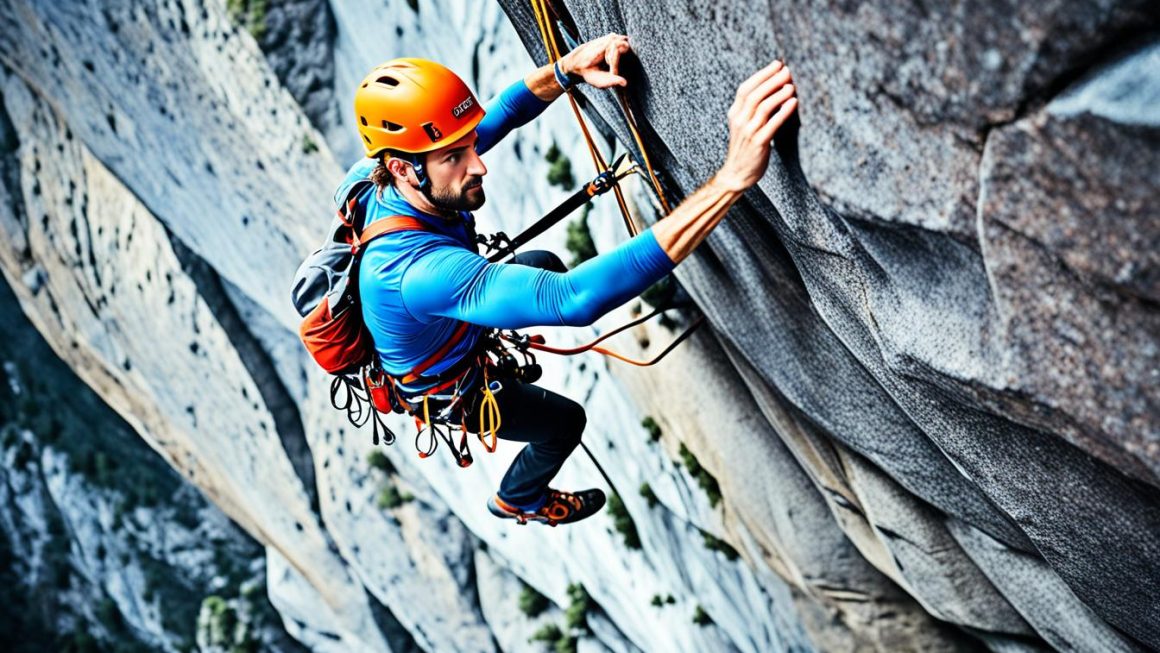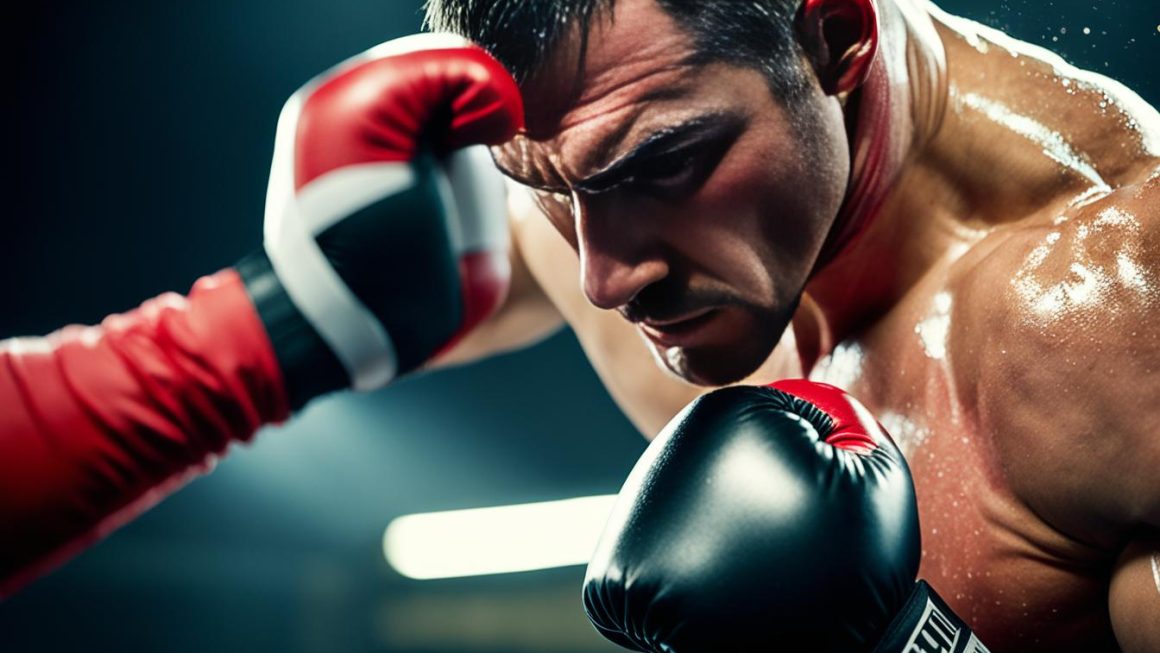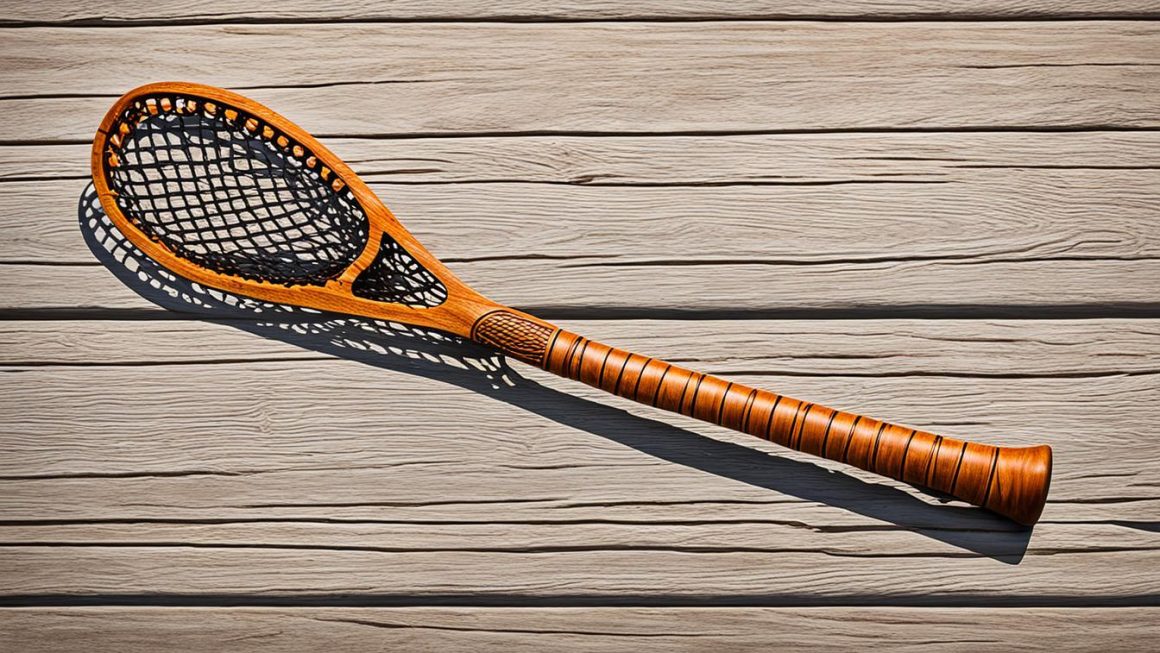Sport climbing is a thrilling and accessible form of rock climbing that allows you to scale vertical walls and conquer heights. Whether you are a beginner or an experienced climber, sport climbing offers a unique and exciting adventure. In this ultimate guide, we will dive into the world of sport climbing, exploring what it is, how to start, essential gear, techniques, top destinations, grading system, and more.
Key Takeaways:
- Sport climbing involves climbing routes protected by fixed bolts and anchors
- It is a popular and accessible activity for climbers of all skill levels
- Starting sport climbing requires proper training and essential gear
- Indoor and outdoor climbing offer different experiences and challenges
- Top sport climbing destinations offer a variety of routes and scenic beauty
What is Sport Climbing?
Sport climbing is a thrilling form of rock climbing that involves ascending single- or multi-pitch routes protected by fixed bolts and anchors drilled into the rock. Unlike bouldering, which focuses on shorter routes with crash pads for protection, sport climbing requires the use of a rope and a belayer for safety.
Sport climbing routes are typically higher and more challenging than bouldering routes, offering climbers the opportunity to test their endurance and technique. The fixed bolts and anchors provide protection along the route, allowing climbers to clip into them as they ascend. This allows for a greater sense of security and minimizes the risk of a fall.
Sport climbing is a popular activity in climbing gyms, where climbers can practice their skills and train in a controlled environment. It is also a great introduction to the world of climbing for beginners, providing a safe and supportive space to learn the necessary techniques and build strength.
To give you a better idea of what sport climbing entails, here’s an image that showcases a climber scaling a challenging route:
The Basics of Sport Climbing
Before embarking on your sport climbing journey, it is crucial to equip yourself with the necessary skills and gear essentials. Firstly, finding a mentor who can guide you through the fundamentals and safety precautions is highly recommended. They can teach you how to tie knots, properly clean a sport climbing anchor, and efficiently clip quickdraws. These techniques are essential for your safety and to ensure a smooth climbing experience.
When it comes to sport climbing gear, there are a few essentials that you’ll need. Let’s take a look at each one:
- A Comfortable and Well-made Harness: A good harness is a critical piece of equipment that keeps you secure and comfortable during climbs. Look for well-known brands like Black Diamond or Petzl that prioritize safety and durability.
- Climbing Shoes: Finding climbing shoes that fit your feet well is essential for achieving precise footwork and maintaining a solid grip on the rock surface. Consider trying on different brands and styles to find the perfect fit for you.
- Durable Rope: Selecting a suitable rope is crucial for sport climbing. The length and diameter of the rope depend on the routes you plan to climb. Be sure to choose a high-quality and durable rope to ensure your safety.
- Quickdraws: Quickdraws are used to attach the rope to the bolts on the climbing route. Opt for lightweight and easy-to-use quickdraws that offer smooth clipping action.
- Belay Device: A belay device is a crucial tool for controlling the rope and securing your climbing partner. Choose a belay device that suits your preferences and provides a secure belaying experience.
- Chalk Bag: A chalk bag is used to store chalk and help maintain a firm grip on holds. Look for a chalk bag that is spacious and easy to access, allowing you to chalk up quickly during climbs.
- Backpack: A spacious backpack is essential for carrying all your climbing gear to the climbing area. Look for a backpack that is comfortable, durable, and has enough storage space for your essentials.
In addition to these essentials, there are optional accessories that can enhance your sport climbing experience. Belay gloves provide added protection to your hands, belay glasses help reduce neck strain while belaying, and a helmet offers extra safety in case of falls or rockfall. Consider adding these accessories to your gear list for enhanced comfort and protection.
Remember, having the right skills and gear is crucial for your safety and success in sport climbing. Learn the techniques, invest in high-quality gear from trusted brands, and get ready to embark on an exhilarating climbing adventure!
How Sport Climbing Works
In sport climbing, the climber and the belayer tie into one end of a single rope. As the climber ascends the route, they clip into carabiners attached to the fixed bolts at regular intervals. The belayer feeds slack in the rope and brakes any falls with the help of a belay device. The climbs can be single-pitch or multi-pitch, depending on the length of the route and the wall. The process of climbing involves a combination of physical strength, technique, and mental focus.
| Key Elements of Sport Climbing | Details |
|---|---|
| 1. Rope and Belay | The climber and the belayer are connected by a dynamic rope for safety. The belayer manages the rope, providing slack and preventing falls. |
| 2. Fixed Bolts | The route is equipped with fixed bolts that act as protection points. Climbers clip their carabiners into these bolts to secure themselves. |
| 3. Carabiners | Carabiners are used to attach the climber’s rope to the fixed bolts. They allow for quick and secure clipping during the ascent. |
| 4. Belay Device | The belayer uses a belay device to manage the rope, control the speed of the climber’s ascent, and lock off in case of a fall. |
| 5. Technique | Sport climbing requires various techniques, such as proper footwork, efficient use of handholds, and body positioning for balance and stability. |
Choosing the Right Gear for Sport Climbing
When it comes to sport climbing, having the right gear is essential for your safety and success on the wall. Investing in high-quality and reliable equipment will not only enhance your climbing experience but also give you peace of mind while tackling challenging routes. Here are the sport climbing gear essentials you need to consider:
Harness:
Choose a comfortable harness that provides proper support and allows for easy movement. Brands like Black Diamond and Camp offer a range of harness options designed specifically for sport climbing.
Climbing Shoes:
Select climbing shoes that fit you well and provide excellent grip on the rock. Proper footwear is crucial for precise foot placements and maintaining balance during climbs.
Rope:
Opt for a durable rope of the appropriate length and diameter for your climbing needs. A reliable rope is the lifeline that keeps you connected to your belayer and ensures your safety during ascents and descents.
Quickdraws:
Quickdraws are used for clipping into the bolts along the climbing route. Choose lightweight and durable quickdraws that make it easy to secure the rope to the fixed protection points.
Belay Device:
A belay device is essential for securing the rope and controlling the tension when belaying your climbing partner. Look for a device that is easy to use and offers smooth rope handling.
Chalk Bag:
A chalk bag is a handy accessory that allows you to keep your hands dry and improve your grip on the rock. Consider getting a chalk bag with a secure closure system and enough capacity to hold an adequate amount of chalk.
Backpack:
A spacious backpack is necessary to carry all your gear to the climbing area. Look for a backpack with multiple compartments and comfortable straps for easy transportation.
In addition to the essentials, there are optional accessories that can enhance your safety and comfort:
- Belay Gloves: Provide extra protection for your hands while belaying or rappelling.
- Belay Glasses: Reduce neck strain by allowing you to look up at your climbing partner without craning your neck.
- Helmet: Protect your head from falling rocks or other potential hazards during climbing.
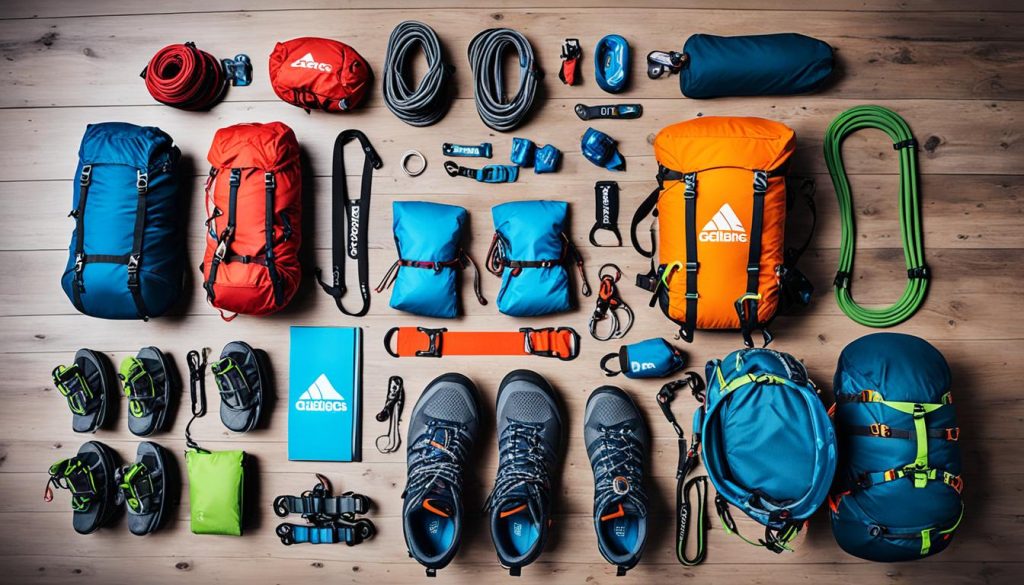
By choosing the right gear for sport climbing, you’ll be equipped to tackle new challenges, push your limits, and enjoy the thrill of scaling vertical heights. Remember to prioritize safety and invest in reliable equipment from reputable brands. Now that you’re equipped with the essentials, it’s time to hit the crag and experience the exhilaration of sport climbing firsthand!
Indoor Sport Climbing vs. Outdoor Climbing
Indoor sport climbing and outdoor climbing offer different experiences and challenges. Whether you prefer the controlled environment of a climbing gym or the thrill of ascending real rock, there are unique benefits to both types of climbing. Let’s take a closer look at the characteristics of each.
Indoor Sport Climbing
Indoor climbing gyms provide a safe and controlled environment for beginners to learn and practice climbing techniques. Unlike outdoor climbing, indoor routes are equipped with pre-clipped perma-draws, making it easier to focus on the climbing itself without the added task of placing protection. Additionally, the walls in indoor gyms are padded with foam, ensuring a soft landing in case of a fall. This creates a low-risk environment that is ideal for beginners or those looking to refine their skills.
Outdoor Climbing
Outdoor climbing offers the excitement of climbing on real rock, with a greater sense of adventure and exposure to natural elements. The rock formations, textures, and landscapes are unique to each outdoor climbing area, providing a diverse range of challenges and scenic beauty. Outdoor climbing requires climbers to be more self-reliant in terms of route finding, protection placement, and managing potential hazards. It offers a deeper connection with nature and a sense of exploration that cannot be replicated indoors.
“Climbing is a balance between control and chaos, and both indoor and outdoor climbing contribute to the development of different skills and mindsets.”
Both indoor and outdoor climbing have their own appeal and attract different types of climbers. Indoor climbing gyms are a great entry point for beginners, allowing them to learn the fundamentals in a safe and supportive environment. It also provides a convenient option for those living in urban areas where outdoor climbing is less accessible.
On the other hand, outdoor climbing offers a more authentic and adventurous experience that many climbers seek. The physical and mental challenges presented by real rock and unpredictable weather conditions add an extra layer of excitement and fulfillment.
Ultimately, the choice between indoor sport climbing and outdoor climbing depends on your personal preferences, goals, and access to climbing areas. Some climbers enjoy the balance of both, using indoor gyms for training and honing their skills while venturing outdoors to put those skills to the test on natural rock.
Remember, regardless of the climbing environment you choose, safety should always be a top priority. Proper training, the use of appropriate gear, and respect for the climbing community and the natural environment are essential for an enjoyable climbing experience.
Indoor Sport Climbing vs. Outdoor Climbing: A Comparison
| Indoor Sport Climbing | Outdoor Climbing |
|---|---|
| Controlled environment | Real rock and natural elements |
| Pre-clipped perma-draws | No pre-placed protection |
| Padded walls for safety | Natural terrain |
| Beginner-friendly | Adventure and exploration |
| Convenient in urban areas | Scenic beauty and diverse challenges |
| Controlled risk | Higher risk and self-reliance |
Top Sport Climbing Destinations
When it comes to sport climbing, the world is your playground. From breathtaking rock formations to diverse routes, there are countless top sport climbing destinations that cater to climbers of all levels. Whether you’re a beginner or an experienced climber seeking a challenge, these destinations offer everything you need for an unforgettable climbing experience.
Owens River Gorge, California
Located in the eastern Sierra Nevada mountains, Owens River Gorge is a paradise for sport climbers. It offers over 900 routes ranging from easy to advanced, making it an ideal destination for climbers of all skill levels. The stunning basalt cliffs provide excellent friction for climbing, ensuring a thrilling adventure.
Red Rock, Nevada
Renowned for its vibrant red sandstone cliffs, Red Rock in Nevada is a world-class sport climbing destination. The area features a variety of trad and sport routes, offering something for everyone. With over 2,000 routes to choose from, climbers can test their skills on vertical faces, cracks, and overhangs.
Ten Sleep, Wyoming
Tucked away in the Bighorn Mountains, Ten Sleep is a hidden gem for sport climbing enthusiasts. Known for its limestone cliffs, the area boasts over 1,000 sport routes with a wide range of difficulty levels. Climbers can enjoy picturesque views and challenging climbs amidst the tranquility of the Wyoming wilderness.
Shelf Road, Colorado
Situated near Colorado Springs, Shelf Road offers a unique sport climbing experience on limestone cliffs. With more than 1,000 bolt-protected routes, climbers can challenge themselves on vertical and overhanging walls. The accessible nature of the area makes it a popular choice for both locals and visitors.
Red River Gorge, Kentucky
Nestled in the Daniel Boone National Forest, Red River Gorge is a mecca for sport climbers. The sandstone cliffs provide exceptional friction, allowing climbers to tackle a wide range of challenging routes. The area’s natural beauty and world-class climbing make it a must-visit destination.
Rumney, New Hampshire
Rumney is a premier destination for sport climbing in the northeastern United States. The granite cliffs offer a variety of routes with diverse features, including cracks, slabs, and steep faces. Climbers can enjoy the scenic beauty of the White Mountains while pushing their limits on the challenging routes.
| Destination | Location | Number of Routes | Difficulty Range |
|---|---|---|---|
| Owens River Gorge | California | 900+ | Easy to advanced |
| Red Rock | Nevada | 2,000+ | Varied |
| Ten Sleep | Wyoming | 1,000+ | Wide range |
| Shelf Road | Colorado | 1,000+ | Varied |
| Red River Gorge | Kentucky | Varied | Varied |
| Rumney | New Hampshire | Varied | Varied |
Understanding Sport Climbing Grades
Sport climbing routes are graded based on difficulty using the numerical French grading system. This system provides climbers with a clear understanding of the level of challenge they can expect from a particular route. By familiarizing yourself with the grading system, you can choose routes that match your skill level and track your progress as you improve.
The French grading system for sport climbing ranges from 5.0 (easiest) to 5.15 (most difficult). Within each numerical grade, there are further subdivisions denoted by letters (a, b, c, and d) to indicate smaller increments of difficulty. For example, a route graded as 5.10a would be slightly harder than a 5.10 route.
Here is a breakdown of the French grading system for sport climbing:
| Grade | Description |
|---|---|
| 5.0-5.5 | Beginner-level routes with large holds and straightforward moves. |
| 5.6-5.8 | Slightly more challenging routes with smaller holds and more technical moves. |
| 5.9-5.10 | Intermediate-level routes that require solid technique and strength. |
| 5.11-5.12 | Advanced-level routes with difficult sequences and demanding climbing. |
| 5.13-5.15 | Expert-level routes that push the limits of difficulty and physical ability. |
It’s important to note that the grading system can vary slightly between different climbing areas and countries. Additionally, the grades themselves can be subjective, as climbing styles and individual strengths and weaknesses can influence the perceived difficulty of a route.
As you progress in your climbing journey, it’s common for climbers to challenge themselves by attempting harder grades. Pushing your limits and gradually tackling more difficult routes is a great way to improve your climbing skills and gain confidence on the wall.
The History of Sport Climbing
Sport climbing has a rich and intriguing history that traces back to the late 1970s and 1980s. During this time, climbers in Europe, particularly in the Verdon Gorge of France, pioneered the development of sport climbing as we know it today. These visionary climbers started installing protection bolts on previously unclimbed cliffs, leading to a significant shift in climbing practices. This innovation allowed climbers to partake in the exhilaration of free climbing without relying on traditional gear for protection.
In parallel, sport climbing was also gaining momentum in North America. Climbers like Alan Watts in Smith Rock State Park, Oregon, were at the forefront of rap-bolting routes that had not been climbed before. This groundbreaking approach expanded the possibilities for climbing, opening up new routes and pushing the boundaries of the sport.
The evolution of sport climbing sparked heated debates within the climbing community. These discussions revolved around climbing ethics and the use of fixed bolts. Some traditionalists argued that climbing should adhere to more purist principles, while others embraced the enhanced accessibility and safety provided by fixed bolts. Despite the controversies, the widespread adoption of fixed bolts ultimately shaped the modern version of sport climbing.
Today, sport climbing continues to thrive and captivate climbers of all levels. It blends physical challenges, mental focus, and a sense of adventure, making it a beloved pursuit for enthusiasts worldwide.
Table: Key Milestones of Sport Climbing History
| Time Period | Significant Developments |
|---|---|
| Late 1970s – 1980s | Creation of sport climbing in Europe and North America with the installation of protection bolts on cliffs |
| Contemporary | Debates over climbing ethics and the acceptance of fixed bolts as a staple gear |
| Present | Sport climbing as a popular and accessible form of climbing enjoyed by enthusiasts globally |
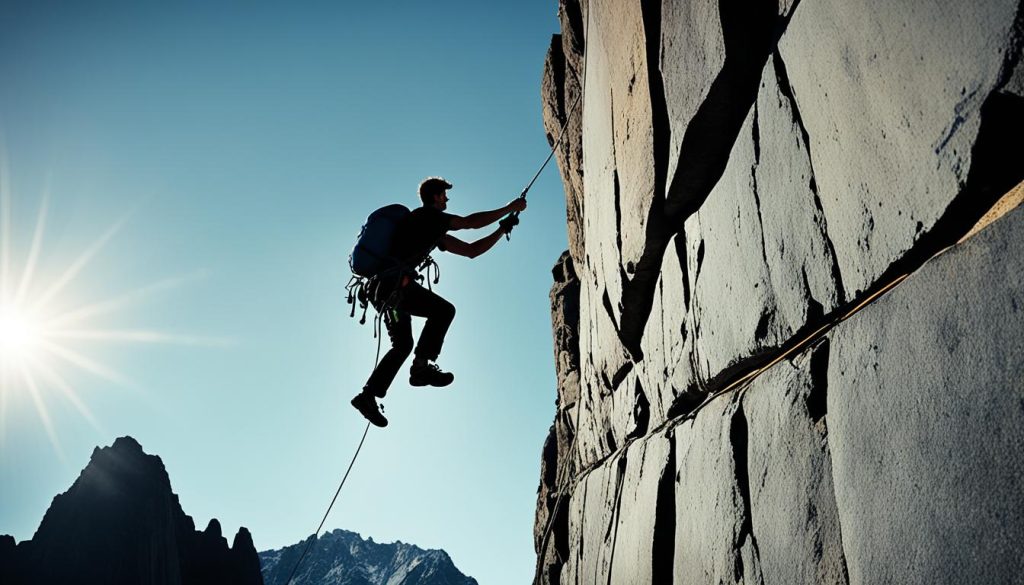
Climbing Etiquette in Sport Climbing
When engaging in sport climbing, it’s essential to practice good climbing etiquette to ensure a positive experience for yourself and fellow climbers.
- Keep noise levels low: Excessive noise can disrupt the concentration of other climbers. Respect the peaceful nature of the climbing environment and refrain from loud conversations or playing music.
- Respect the natural environment: Treat the climbing area with care and respect. Avoid littering and make sure to dispose of trash properly. Leave the area as you found it or better.
- Take turns on the routes: Be mindful of other climbers waiting to use the same route. Allow others the opportunity to climb without interruption by taking turns and adhering to a fair rotation system if necessary.
- Familiarize yourself with the rules and regulations: Each climbing area may have specific guidelines and regulations. Take the time to learn and respect these rules to ensure the safety and enjoyment of all climbers.
- Communicate in a friendly and considerate manner: Interact with fellow climbers in a respectful and positive way. Offer encouragement and support, and be open to collaboration and sharing of knowledge.
By following these guidelines, you contribute to a harmonious climbing community and help create a welcoming environment for everyone to enjoy this exhilarating sport.
| Do’s | Don’ts | |
|---|---|---|
| Keep Noise Levels Low | – Use a moderate speaking volume – Be mindful of others’ concentration |
– Engage in loud conversations – Play loud music |
| Respect the Natural Environment | – Dispose of trash properly – Leave no trace behind |
– Litter the climbing area – Damage flora or fauna |
| Take Turns on the Routes | – Allow others the opportunity to climb – Respect a fair rotation system |
– Hog a route without considering others – Refuse to share the climbing area |
| Familiarize with Rules and Regulations | – Learn and follow climbing area guidelines – Respect access restrictions |
– Ignore posted rules and regulations – Engage in dangerous or prohibited activities |
| Communicate Friendly and Considerately | – Offer encouragement and support – Share knowledge and experiences |
– Engage in disrespectful behavior – Use aggressive or derogatory language |
Conclusion
Sport climbing is an exhilarating and accessible form of climbing that offers a wide range of benefits. By scaling routes protected by fixed bolts and anchors using a belayer and a rope, you can experience the thrill of conquering vertical challenges. With the right gear and proper training, anyone can partake in this exciting sport.
Whether you prefer climbing indoors or venturing into the great outdoors, sport climbing provides a unique and rewarding experience. From well-known destinations like Owens River Gorge and Red River Gorge to hidden gems waiting to be explored, there are countless opportunities to embark on your vertical journey.
Whether you’re a seasoned climber or a beginner, sport climbing offers tremendous physical benefits while honing your technique and mental focus. It’s a sport that keeps you active, challenges your limits, and fosters a competitive edge in a supportive community.
So, grab your harness, lace up your climbing shoes, and embrace the adventure. Start exploring the world of sport climbing today and discover the joy of scaling new heights.
